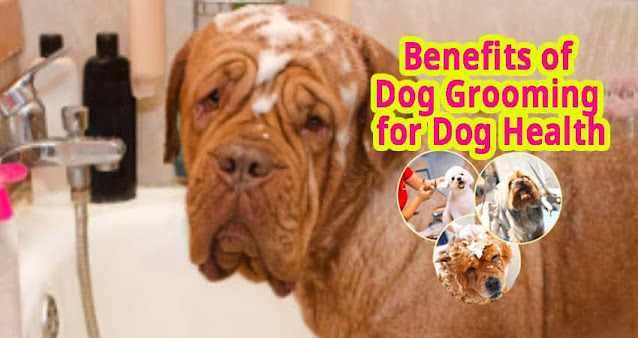What is Grooming?
Dog grooming refers to the process of maintaining a dog's physical appearance and hygiene through various grooming practices. It involves a range of tasks, including brushing or combing the dog's coat to remove tangles and loose hair, bathing to clean the skin and coat, trimming or clipping the hair to achieve a desired length or style, nail trimming to maintain proper foot health, ear cleaning to prevent infections, and dental care to promote oral hygiene. Grooming sessions also include checking for any skin issues, parasites, or abnormalities.
Regular grooming not only helps keep dogs looking their best but also contributes to their overall health and well-being by preventing matting, controlling shedding, and detecting any potential health problems early on. While some dog owners prefer to groom their pets at home, others may choose to take their dogs to professional groomers who specialize in providing comprehensive grooming services. Dog grooming is not only about aesthetics but also plays a crucial role in promoting a dog's comfort, cleanliness, and overall happiness.
Dog Grooming Tips & Tricks
7 Benefits of Dog Grooming for Dog Health
Regular dog grooming offers several benefits for the health and well-being of dogs. Here are seven key advantages:
1. Skin and Coat Health: Grooming helps maintain a clean and healthy coat by removing dirt, debris, and dead hair. It stimulates the skin, promotes oil distribution, and reduces the risk of skin irritations or infections.
2. Shedding Control: Regular brushing and grooming help manage shedding by removing loose hair and minimizing the amount of hair that ends up on furniture and clothes.
3. Mat Prevention: Frequent grooming prevents mats and tangles from forming in the dog's coat. Mats can be uncomfortable and even painful for dogs, and they can also trap moisture and lead to skin issues.
4. Detection of Skin Issues: During grooming sessions, you can inspect your dog's skin for any abnormalities, such as rashes, dryness, or parasites. Early detection allows for prompt treatment and prevents potential complications.
1. Nail and Paw Care: Trimming your dog's nails is an essential part of grooming. Overgrown nails can cause discomfort, affect their gait, and potentially lead to nail injuries. Grooming also includes checking and cleaning the paws, ensuring they are free from debris, and preventing paw pad issues.
2. Ear Cleaning: Regular grooming includes cleaning your dog's ears to remove dirt, wax, and debris. This reduces the risk of ear infections and promotes overall ear health.
3. Dental Care: Grooming sessions often involve teeth brushing or dental care, which helps maintain good oral hygiene. Regular dental care can prevent dental diseases, bad breath, and tooth loss in dogs.
Overall, regular dog grooming not only enhances their appearance but also contributes to their physical health, comfort, and overall happiness.
Do Dogs Need Daily Grooming?
The frequency of dog grooming depends on various factors, including the breed, coat type, and individual needs of the dog. While some dogs may benefit from daily grooming, most dogs do not require grooming on a daily basis. However, regular grooming sessions are still essential for maintaining their health and well-being.
For dogs with longer or thicker coats, such as poodles or shih tzus, daily brushing may be necessary to prevent matting and tangles. Breeds with shorter coats, like beagles or boxers, may only require brushing once or twice a week to remove loose hair. Bathing frequency can vary from monthly to every few months, depending on the dog's activity level, coat condition, and any specific skin issues they may have.
Other aspects of grooming, such as nail trimming, ear cleaning, and dental care, should be performed regularly but not necessarily on a daily basis. Nail trimming is typically needed every few weeks, while ear cleaning and dental care can be done once a week or as advised by a veterinarian.
It's important to remember that grooming goes beyond just maintaining the physical appearance of a dog. It also provides an opportunity to bond with your pet and monitor their overall health. Observing your dog's coat, skin, ears, and teeth during grooming sessions allows you to identify any potential issues early on and seek appropriate veterinary care if needed.
In summary, while dogs do not require daily grooming in most cases, regular grooming sessions tailored to their specific needs and breed characteristics are essential for their health, comfort, and overall well-being.
What Factors are Considered in Grooming?
When grooming your dog, there are several things to consider to ensure a safe and effective grooming session:
1. Safety: Ensure the grooming area is safe and free of hazards. Use non-slip mats or towels to prevent your dog from slipping and getting injured during the process.
Proper Tools: Use appropriate grooming tools for your dog's specific coat type. This may include brushes, combs, clippers, and scissors. Make sure the tools are clean, well-maintained, and suitable for your dog's size and coat length.
3. Gentle Approach: Be gentle and patient while grooming your dog. Use a calm and reassuring tone to keep your dog relaxed. Avoid pulling or tugging on the coat, as it can cause discomfort or pain.
4. Brushing: Start by brushing or combing your dog's coat to remove tangles, mats, and loose hair. Use gentle strokes and work through the coat in the direction of hair growth.
5. Bathing: If bathing is necessary, use a dog-specific shampoo and warm water. Protect your dog's eyes and ears from water and soap. Thoroughly rinse off all shampoo to prevent skin irritation.
6. Nail Trimming: Trim your dog's nails carefully, avoiding the quick (the sensitive part containing blood vessels). Use sharp, proper nail clippers designed for dogs, and consider having styptic powder or a styptic pen on hand to stop bleeding in case of accidental cuts.
7. Ear Cleaning: Gently clean your dog's ears using a dog-specific ear-cleaning solution and cotton balls or pads. Avoid inserting anything deep into the ear canal and stop if your dog shows discomfort or pain.
8. Dental Care: Regularly brush your dog's teeth using dog-specific toothpaste and a soft toothbrush. Gradually introduce dental care to your dog and make it a positive experience.
9. Professional Help: Seek professional grooming assistance for complex tasks such as intricate haircuts or if you are uncomfortable handling certain grooming procedures.
Remember to reward your dog with praise, treats, or breaks during and after the grooming session to make it a positive experience. Regular grooming not only keeps your dog clean and healthy but also strengthens the bond between you and your furry friend.
People Also Ask
How often should you bathe your dog?
The frequency of bathing your dog depends on various factors, such as breed, coat type, activity level, and overall health. Generally, most dogs benefit from bathing every few months or as needed. Overbathing can strip the natural oils from their skin, leading to dryness and irritation. However, dogs that spend a lot of time outdoors, are more active, or frequently get dirty may require more frequent baths. Breeds with oily or water-repellent coats may need less frequent bathing, while those with hair instead of fur may need more regular bathing and specialized grooming. It's essential to use a dog-specific shampoo that is mild, hypoallergenic, and suitable for their skin and coat type. If in doubt, consult with a veterinarian for personalized guidance on bathing frequency and maintaining your dog's overall hygiene.
What are the Four Parts of the Dog that Should be Groomed Regularly?
Three parts of a dog that should be groomed regularly are the teeth, nails, and ears. Regular teeth brushing or dental care helps maintain good oral hygiene and prevent dental diseases. Trimming the nails prevents overgrowth, which can lead to discomfort or injury. Cleaning the ears helps remove dirt, wax, and debris, reducing the risk of ear infections. Besides, regular brushing and combing help to keep the coat clean, remove tangles and loose hair, and distribute natural oils. By regularly grooming these areas, you can promote your dog's overall health, comfort, and well-being.
You Might be Interested: Why is Cat Tongue Rough?












0 Comments